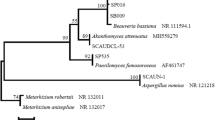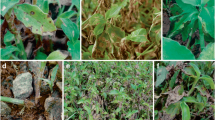Abstract
Stagonospora convolvuli LA39, an effective biocontrol agent of Convolvulus arvensis (field bindweed) and Calystegia sepium (hedge bindweed) produces phytotoxic metabolites leptosphaerodione and elsinochrome A. Stagonospora isolate 214Caa produces the toxin cercosporin. If toxic metabolite production is not linked to the pathogenic ability of the fungus on bindweeds, selection of aggressive strains with limited or no production of the metabolites would reduce any perceived risk of using strains of the fungus as a mycoherbicide. Therefore, 30 isolates of Stagonospora sp. including LA39 and 214Caa were characterised for aggressiveness on both bindweeds, and production of the three metabolites. Nine isolates were more aggressive than LA39 on both bindweeds. Classification of isolates based on metabolite type agreed largely with previous similar characterisation based on polymerase chain reaction-restriction fragment length polymorphism of internal transcribed spacer of ribosomal DNA. Cercosporin producers produced neither leptosphaerodione nor elsinochrome A and together with isolates that produce none of the three metabolites, were less pathogenic on bindweeds. Conversely, there was a positive correlation between elsinochrome A and leptosphaerodione production, and each was positively correlated with aggressiveness of isolates on both bindweeds. Generally, any isolate where elsinochrome A was not detected was not aggressive on any of the two bindweeds. This probably implies that selecting elsinochrome A-negative, but aggressive Stagonospora strain(s) may be difficult. However, aggressive isolates may not produce elsinochrome A in planta at levels that could constitute any risk in the environment. In a preliminary attempt to determine the levels of elsinochrome A and leptosphaerodione produced in diseased bindweeds, none of the toxins was detected in Stagonospora infected bindweed leaves. Detailed investigation focusing on the detection and quantification of in planta production of elsinochrome A by Stagonospora isolates, and determination of the fate of elsinochrome A in the environment, and its relationship with leptosphaerodione may be essential. Similarly, development of molecular tools to monitor the mycoherbicide following field application is vital.
Similar content being viewed by others
References
H-U Ammon H Müller-Schärer (1999) ArticleTitleProspects for combining biological weed control with integrated crop production systems, and with sensitive management of alpine pastures in Switzerland Journal of Plant Diseases and Plant Protection 106 213–220
A Arnone L Merlini R Mondellil G Nasini E Ragg L Scaglioni (1993) ArticleTitleStructure, conformational analysis and absolute configuration of the perylenequinone pigments elsinochromes B1, B2, C1 and C2 Gazetta Chimica Italiana 123 131–136 Occurrence Handle1:CAS:528:DyaK3sXmsV2ktLw%3D
C Balis MG Payne (1971) ArticleTitleTriglycerides and cercosporin from Cercospora beticola: fungal growth and cercosporin production Phytopathology 61 1477–1484 Occurrence Handle1:CAS:528:DyaE38XmvFOkuw%3D%3D Occurrence Handle10.1094/Phyto-61-1477
PE Boldt SS Rosenthal R Srinivasan (1998) ArticleTitleDistribution of field bindweed and hedge bindweed in the USA Journal of Production Agriculture 11 377–381
C-T Chen K Nakanishi S Natori (1966) ArticleTitleBiosynthesis of elsinochrome A, the perylenequinone from Elsinoe spp. 1. Chemical and Pharmaceutical Bulletin 14 1434–1437 Occurrence Handle1:CAS:528:DyaF2sXntlGntQ%3D%3D
ME Daub (1982) ArticleTitleCercosporin, a photosensitizing toxin from Cercospora species Phytopathology 72 370–374 Occurrence Handle1:CAS:528:DyaL38XitFahsr4%3D Occurrence Handle10.1094/Phyto-72-370
ME Daub M Ehrenshaft (1993) ArticleTitleThe photoactivated toxin cercosporin as a tool in fungal photobiology Physiologia Plantarum 89 227–236 Occurrence Handle10.1111/j.1399-3054.1993.tb01810.x Occurrence Handle1:CAS:528:DyaK3sXms1Glsrw%3D
ME Daub M Ehrenshaft (2000) ArticleTitleThe photoactive cercospora toxin cercosporin: contributions to plant disease and fundamental biology Annual Review of Phytopathology 38 461–490 Occurrence Handle11701851 Occurrence Handle10.1146/annurev.phyto.38.1.461 Occurrence Handle1:CAS:528:DC%2BD3cXot1Sju7g%3D
ME Daub RP Hangarter (1983) ArticleTitleProduction of singlet oxygen and superoxide by the fungal toxin, cercosporin Plant Physiology 73 855–857 Occurrence Handle16663313 Occurrence Handle1:CAS:528:DyaL2cXks1Kktg%3D%3D Occurrence Handle10.1104/pp.73.3.855
ME Daub GB Leisman RA Clark EF Bowden (1992) ArticleTitleReductive detoxification as a mechanism of fungal resistance to singlet-oxygen-generating photosensitizers Proceedings of National Academy of Science USA 89 9588–9592 Occurrence Handle10.1073/pnas.89.20.9588 Occurrence Handle1:CAS:528:DyaK3sXjtVSq
JG Davison (1976) ArticleTitleControl of bindweeds Convolvulus arvensis and Calystegia sepium in fruit crops Pesticide Science 7 429–435 Occurrence Handle10.1002/ps.2780070502 Occurrence Handle1:CAS:528:DyaE2sXms1KrsA%3D%3D
G Défago H-U Ammon L Cagán B Draeger MP Greaves D Guntli D Hoeke L Klimes J Lawrie Y Moënne-Loccoz B Nicolet HA Pfirter R Tabacchi P Tóth (2001) ArticleTitleTowards the biocontrol of bindweeds with a mycoherbicide BioControl 46 157–173 Occurrence Handle10.1023/A:1011441816615
AO Fajola (1978) ArticleTitleCercosporin, a phytotoxin from Cercospora species Physiological Plant Pathology 13 157–164 Occurrence Handle10.1016/0048-4059(78)90029-2 Occurrence Handle1:CAS:528:DyaE1cXmtFaitrs%3D
A Guerriero M Dambrosio V Cuomo F Pietra (1991) ArticleTitleA novel, degraded polyketidic lactone, leptosphaerolide, and its likely diketone precursor, leptosphaerodione: Isolation from cultures of the marine ascomycete Leptosphaeria oraemaris (Linder) Helvetica Chimica Acta 74 1445–1450 Occurrence Handle10.1002/hlca.19910740707 Occurrence Handle1:CAS:528:DyaK38XhvVWnsw%3D%3D
D Guntli HA Pfirter Y Moënne-Loccoz G Défago (1998) ArticleTitleStagonospora convolvuli LA39 for biocontrol of field bindweed infesting cotoneaster in a cemetery Horticultural Science 33 860–861
PE Hartman CK Suzuki ME Stack (1989) ArticleTitlePhotodynamic production of superoxide in vitro by altertoxins in the presence of reducing agents Applied Environmental Microbiology 55 7–14 Occurrence Handle1:CAS:528:DyaL1MXptVaqsw%3D%3D
LG Holm DL Plucknett JV Pancho JP Herberger (1977) The World’s Worst Weeds The University Press of Hawaii Honolulu
AE Jenns ME Daub RG Upchurch (1989) ArticleTitleRegulation of cercosporin accumulation in culture by medium and temperature manipulation Phytopathology 79 213–219 Occurrence Handle10.1094/Phyto-79-213 Occurrence Handle1:CAS:528:DyaL1MXhvV2isLs%3D
L Klimeš J Klimešová (1994) ArticleTitleBiomass allocation in a clonal vine: effects of intraspecific competition and nutrient availability Folia Geobotanica Phytotaxonomica 29 237–244 Occurrence Handle10.1007/BF02803798
RC Littell GA Milliken WW Stroup RD Wolfinger (1996) SAS©System for Mixed Models SAS Institute Inc. Cary, NC
FJ Lynch MJ Geoghegan (1979) ArticleTitleRegulation of growth and cercosporin photoinduction in Cercospora beticola Transactions of the British Mycological Society 73 373–379 Occurrence Handle10.1016/S0007-1536(79)80116-3
L Ma H Tai C Li Y Zhang ZH Wang WZ Ji (2003) ArticleTitlePhotodynamic inhibitory effects of three perylenequinones on human colorectal carcinoma cell line and primate embryonic stem cell line World Journal of Gastroenterology 9 485–490 Occurrence Handle12632502 Occurrence Handle1:CAS:528:DC%2BD3sXjtVersbw%3D
Nicolet B (1999) Isolement et identification de métabolites secondaires de deux souches de champignon Stagonospora sp., agent pathogène du liseron des haies (Calystegia sepium) et du liseron des champs (Convolvulus arvensis). Travail de thèse, Faculté des Sciences, Université de Neuchâtel
B Nicolet R Tabacchi (1999) Secondary metabolites produced by Stagonospora sp., a potential biocontrol agent against bindweeds H Lyr PE Russell HD Sisler (Eds) Modern Fungicides and Antifungal Compounds II Intercept Limited, Andover United Kingdom 469–476
HA Pfirter G Défago (1998) ArticleTitleThe potential of Stagonospora sp. as a mycoherbicide for field bindweed Biocontrol Science and Technology 8 93–101 Occurrence Handle10.1080/09583159830469
HA Pfirter HU Ammon D Guntli MP Greaves G Défago (1997) ArticleTitleTowards the management of field bindweed (Convolvulus arvensis) and hedge bindweed (Calystegia sepium) with fungal pathogens and cover crops Integrated Pest Management Reviews 2 1–9 Occurrence Handle10.1023/A:1018432513776
HA Pfirter F Marquis G Défago (1999) ArticleTitleGenetic and pathogenic characterisation of different Stagonospora sp. isolated from bindweeds Biocontrol Science and Technology 9 555–566 Occurrence Handle10.1080/09583159929514
D Schroeder H Müller-Schärer CSA Stinson (1993) ArticleTitleA European weed survey in 10 major crop systems to identify targets for biological control Weed Research 33 449–458 Occurrence Handle10.1111/j.1365-3180.1993.tb01961.x
GW Snedecor WG Cochran (1989) Statistical Methods EditionNumber8 Iowa State University Press Ames, Iowa
ME Stack EP Mazzola SW Page AE Pohland RS Highet MS Tempesta DG Corley (1986) ArticleTitleMutagenic perylenequinone metabolites of Alternaria alternata: altertoxins I, II, and III Journal of Natural Products 49 866–871 Occurrence Handle3546597 Occurrence Handle10.1021/np50047a017 Occurrence Handle1:CAS:528:DyaL2sXpvFSgsQ%3D%3D
T Tamaoki H Nakano (1990) ArticleTitlePotent and specific inhibitors of protein kinase C of microbiologic origin Biotechnology 8 732–735 Occurrence Handle1370017 Occurrence Handle10.1038/nbt0890-732 Occurrence Handle1:CAS:528:DyaK3cXmt1Kktrs%3D
RG Upchurch DC Walker JA Rollins M Ehrenshaft ME Daub (1991) ArticleTitleMutants of Cercospora kikuchii altered in cercosporin synthesis and pathogenicity Applied Environmental Microbiology 57 2940–2945 Occurrence Handle1:CAS:528:DyaK38XotVWitQ%3D%3D
SE Weaver WR Riley (1982) ArticleTitleThe biology of Canadian weeds. 53. Convolvulus arvensis L. Canadian Journal of Plant Science 62 461–472 Occurrence Handle10.4141/cjps82-066
U Weiss L Merlini G Nasini (1987) Naturally occurring perylenequinones W Herz H Grisebach GW Kirby CH Tamm (Eds) Progress in the Chemistry of Organic Natural Products Springer-Verlag Vienna: 1–71
P Westra P Chapman PW Stahlman SD Miller PK Fay (1992) ArticleTitleField bindweed (Convolvulus arvensis) control with various herbicide combinations Weed Technology 6 949–955 Occurrence Handle1:CAS:528:DyaK3sXhvVGkt7w%3D
S Yamazaki A Okube Y Akiyama K Fuwa (1975) ArticleTitleCercosporin, a novel photodynamic pigment isolated from Cercospora kikuchii Agricultural and Biological Chemistry 39 287–288 Occurrence Handle1:CAS:528:DyaE2MXhtlektLs%3D
Author information
Authors and Affiliations
Corresponding author
Rights and permissions
About this article
Cite this article
Ahonsi, M.O., Maurhofer, M., Boss, D. et al. Relationship between aggressiveness of Stagonospora sp. isolates on field and hedge bindweeds, and in vitro production of fungal metabolites cercosporin, elsinochrome A and leptosphaerodione. Eur J Plant Pathol 111, 203–215 (2005). https://doi.org/10.1007/s10658-004-2878-5
Accepted:
Issue Date:
DOI: https://doi.org/10.1007/s10658-004-2878-5




